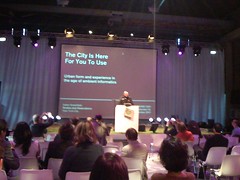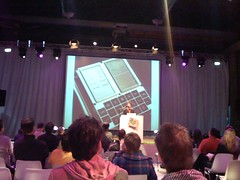PICNIC07: The Near Future of Pervasive Media Experiences, Q&A
September 28, 2007 | CommentsPICNIC07: The Near Future of Pervasive Media Experiences, Q&A
Q: Who's the target market for these games?
Dennis: The street games are difficult to monitise because there's an infrastructure and running cost. The more passive games which run for a longer period are easier.
Nicolas: It's a bit like laser games, requiring a place with a specific infrastructure. My fear is that it could be turned into theme parks. It might be designed for specific targets or niches.
Fabien: I don't see how to get out of this niche or one-shot campaigns.
Dennis: There's a spectrum; at one end you have Pacmanhattan which only 10 people have played, at the other Nike+.
Q: I don't understand why you're pessimistic about the technology. Why can't it be server-based? Location services will become standard, and motion controls like on the Wii be widespread.
Fabien: I heard this 5 years ago. You have to show me a scenario that's engaging for people to use.
Q: We have this in Korea now.
Fabien: We need Koreans over here then. (He's talking about Koreans being somehow genetically predisposed to LBS gaming I think... I'd massively disagree)
PICNIC07: The City Is Here For You To Use, Adam Greenfield
September 28, 2007 | CommentsPICNIC07: The City Is Here For You To Use, Adam Greenfield
Not so much about play, more about cities. Comes from user experience background of developing large-scale web sites. Cares about human experience, not devices.
"How I learned to be an urbanist": Jane Jacobs, Christopher Alexander, Bernard Rudofsky
They worried about cars, traffic, overplanning... we've killed the street without that (though not in Amsterdam where lots of this hasn't happened, as in Seoul).
"The repeating module of doom": Manhattan streets look like a background of a video-game. Walking 10 blocks along the street, you get into a cycle of the same large brand franchises/chains repeating themselves.
Cities keep you deliberately confounded in order to keep you there and spending money. Las Vegas and malls are examples of this: a persistent sense of delocation.
And the environment is actively being made hostile: stealthy, slippery, crusty, prickly and jittery. e.g. postboxes covered with spikes to stop people sitting on it; Tokyo park benches designed to be uncomfortable to sit on, impossible to sleep on, etc.
Mobile devices get us withdrawing from society, instead of engaging with it.
BUT...
 Nostalgia is for suckers. How can we rediscover what it takes to make cities, again? Ubicomp is the answer! Informatic systems embedded into the environment, communicating wirelessly, imperceptible, and post-GUI.
Nostalgia is for suckers. How can we rediscover what it takes to make cities, again? Ubicomp is the answer! Informatic systems embedded into the environment, communicating wirelessly, imperceptible, and post-GUI.
To ambient informatics, and beyond! Information processing at different scales: body, street, etc. Nike+, RFID, etc. Urban information processing. Shinjuku lamp post which reacts to RFID contact with helpful information: infrastructure that has more agency than it used to. All this giving rise to a new model of interaction: e.g. Octopus in Hong Kong, where the entire transaction between card and reader happens in a dance choreographed by women (in particular) swinging their bags over the reader as they go through. A complex set of protocol exchanges turned into a dance.
How will the positive side of this play out?
One natural thing we do with information is visualising it. e.g. Stamen Designs' cabspotting; Paris visualised by wi-fi hot spots; and we can use these visualisations to pipe information back to people inside these places. e.g. maps of street crime made available to mobile devices.
(What are the second-order effects of a closed feedback loop like this - I avoid an area because they are areas I should avoid, so less people go there, so there's less scrutiny...)
Some of these inputs regulate the shape of buildings - e.g. living glass, with sensors that respond to CO2 levels in the room and opens windows to let in oxygen automatically; the incredible Blur Building; the carbon tower, with active lateral balancing based on inhabitants, weather and seismic conditions.
Also: addressable/scriptable objects, screens, surfaces: RFID, augmented reality, semacode/semapedia.
Upshot: a city that responds to its residents and other users (e.g. weather) in real time. "The city is the platform".
These systems will be used to reinscribe class boundaries.
The downside: overlegibility, everything is explicit and there's no room for ambiguity or plausible deniability. Everything is stated, announced, and made social: maybe we don't want our friends to know where we are all the time. Emergent behaviour: we'll have to accept the cost of this.
The upside: more efficient use of natural resources and infrastructure. e.g. letting people how long they have to cross the road before the lights change, saves lives!
New ways to use the city based on these devices. e.g. Nike+ lets Adam run in NY and compete against friends running in London and SF.
So what (whimsically) could this look like, in Amsterdam?
- Coffeeshopper: using sensor networks in coffee shops to break down potency of waste products, to identify coffee shops by strength of product;
- Red Light 2.0: service providers wearing an anklet and the window is a touch display exposing charges, language spoken, etc.
- WhiteBike (beta): free, LBS-tracked bicycles deposited around the city at random. At the end of the day a programme specifies optimal route for pickup, taken by a truck.
"Systems are for cities, and cities are for people"
PICNIC07: New interaction partners, Nicolas Nova
September 28, 2007 | CommentsPICNIC07: New interaction partners, Nicolas Nova
The problem with ubicomp: the model translated into gaming is messy, it's not clean.
Examples: augmenting animals. Shows a cockroach controlling a robot; a rat with survival goggles; special collar to track floating dogs; wiring poultry up to the internet.
How about playing against animals, or using animals as partners in gaming? Pac-man against animals instead of against an AI; or another one where a rodent is pursuing you through a virtual environment.
MMORPGs for pets: a dog running around a physical environment, transmitting its movements to a dwarf inside Wow. Twitter communication with a cat: when the cat scratches the device, the device reports onto Twitter - or when a message is twittered by the owner, it's reflected on the device.
Nicolas is not interested in trivialising animals, bee-dogs, or just controlling them. It's about animals, plants or weather as new interaction partners.
PICNIC07: Julian Bleecker
September 28, 2007 | CommentsWent back to the keyboard, the early human/computer interface. Designed to spell the word "typewriter" with the top row of keys, as a tool for salespeople :) Shows guidance computer from the Apollo landing module, which had 18 keys. Contrast this with the space shuttle ("which doesn't even go to the moon"), a massively complicated bank of controls: it's the same thing but with many more buttons. There hasn't been an evolution of the interfaces (shows compulsory iPhone screenshot).
So where did this interface come from? Doug Engelbart; shows patent diagrams for mouse/computer diagram.
How would computers see us? A being with one eyeball, a huge finger, etc. How might viewing how the computer sees us change the interface in more playful ways. Looks at traditional playground play: physical activity becoming a game controller. Shows children playing a meteors-like game in real time.
He's not a gamer, but is more interested in their playful characteristics. To play WoW, he'd want to be able to take a hike or go for a bike ride and have that be of value within the game experience. Talks about Nike+.
PICNIC07: Identity 2.0, Dick Hardt
September 28, 2007 | CommentsPICNIC07: Identity 2.0, Dick Hardt
Identity is difficult to describe: blind men and elephants. Contrasts German wikipedia entry for "identity" to UK and Dutch ones. Characteristics by which an individual is identifiable, either of herself or as part of her social group.
Lets you separate one person from a group of people; or it's a bunch of different personas. It lets you predict behaviour based on roles: prior knowledge kicks in when you see someone in a uniform, say.
How is it conveyed? Verbally, requiring trust. Official papers enabling trust on a local scale. Modern identity based around photo ID (passports etc).
Where is it used? ID transactions: party identification (who is this?), authorisation, profile exchange (telling something about yourself). Photo ID reduced friction. There's a lot of privacy (DVLA don't interact with a store I might use my driving license as age ID in).
Attributes of identity.
Identity 1.0 is all about records.
Verified digital identity is not what you give to the site, it's what the site builds up about you (e.g. ebay trading history): you can't carry it around with you.
Identity 2.0: a new architecture for this, elements of which are being used during the Olympics. Simple and open wins. Today, identity is closed, complex and stored in silos by individual sites.
2017: broadband everywhere, cheap storage, more use of electronic storage, mobile, device convergence, digital natives. Minimal passwords, rich portable profiles, portable credentials, rich attributes to share with sites, reputation services, proving you're human (to avoid CAPTCHA),
See also here
